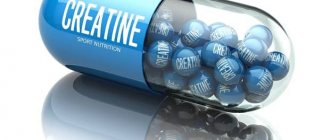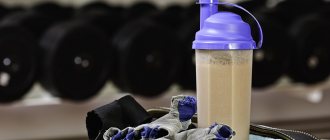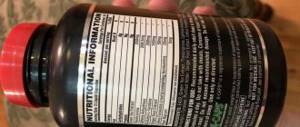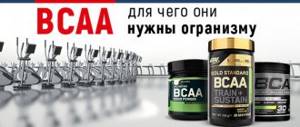How to take the supplement correctly. Required dosages of creatine. What can you mix it with? Do I need a break from taking it? A lot has been said about the benefits of creatine. This is an effective and powerful substance that is capable of many things - rapid muscle recovery, providing the body with energy, additional strength and endurance. Taking creatine allows you to perform 100% of every workout and get the maximum effect. But all this is possible only in one case - you must take creatine correctly. The variety of different theories often confuses professional athletes. Let's figure out where the truth really is.
How to drink?
You should know that creatine intake can be done according to two main schemes:
- With loading (the scheme is most popular among professional athletes):
- how much to drink – five grams of creatine 4-6 times a day. In total, the body should get from 20 to 30 grams of creatine. Such use is an opportunity to quickly saturate muscle fibers with such a useful substance;
- time. Portions should be taken every 4-5 hours. On the day of your workout, take one of the doses immediately after your workout. On a rest day, creatine can be taken at any convenient time between meals (taking into account the recommendations above);
- cooking. Measure out the required portion and wash it down with warm water or, preferably, sweet juice (apple, grape or orange). The maximum effect can be achieved if you take the supplement along with sports nutrition - gainer, protein shake or amino acids;
- duration of the course. Loading time – 5-6 days. After this, the dosage is reduced to 3-5 grams, and the number of doses is limited to once a day. Full cycle – one month;
- break. Upon completion of the course, you need to stop and “rest” from taking creatine. Take a break for 20-30 days;
- special recommendations. It is advisable to take creatine with plenty of water (juice) on an empty stomach.
- Without loading (a scheme that is recommended mostly for beginners):
- how much to drink – five grams of creatine. Frequency of administration: once a day;
- time. Training day - after class, rest day - in the morning before lunch;
- duration. Take the supplement for two months. After this, rest is 20-30 days.
The remaining recommendations do not differ from those given for the download option.
How to cook?
Now let’s figure out how to properly prepare and drink creatine in powder form. Everything is simple here:
- measure the required portion using a measuring spoon. If there is none, then you can use a regular teaspoon. As a rule, such a heaped spoonful of powder is about five grams of the additive (standard dose);
- pour the powder into a special container and fill it with a liter of water (you can use sweet juice);
- mix the additive well. Once you have a homogeneous composition, you can use it.
When to drink?
A big and important question is when to take the supplement (before visiting the gym or after completing a workout). Studies have shown that taking creatine before exercise is not advisable. There are several main reasons here:
- Possible disruption of water metabolism in the body. As a result, taking the supplement can lead to severe dehydration. This should not be allowed under any circumstances;
- the body is not yet ready to transport useful elements, the circulatory system is not yet “overclocked”. As a result, it is useless to take useful substances - they will not be absorbed;
- on the day of training (shortly before it starts), it is advisable to give the body a good portion of carbohydrates (preferably with a low glycemic index). In this case, you can achieve maximum energy for the muscles and they will no longer need such a long rest;
- During training, the body does not need creatine, because muscle reserves are sufficient for training. This is exactly the moment when it is better to take a break from taking the supplement;
- It is not recommended to take this sports nutrition during training. Otherwise, muscle function may be greatly hampered.
What can be concluded? You shouldn’t take a break right after your workout—drink a serving of creatine right away. In this case, the muscles are ready to receive a new portion of useful components. In addition, it is at this time that it is best to take the rest of the sports nutrition - protein mixtures, amino acids and carbohydrates. At the same time, on the rest day, take the supplement when it is convenient.
What is creatine?
Creatine is a substance that is produced in the body with the help of glycine, methionine and arginine. All these amino acids are components of protein. Creatine itself can be synthesized in the kidneys, liver and adrenal glands, and it is located directly where it is needed, that is, in the muscles (about 95% of all creatine is found in muscle tissue). Creatine is often compared in terms of benefits to proteins, fats and carbohydrates, which is not far from the truth. The situation in the sports industry is identical - creatine in supplement form is as necessary as a protein or gainer.
Although it is produced in the body, the amount produced is too small. As a rule, it is enough for normal physical activity (movements, a short jog, etc.), but during sports, the requirements for this substance increase significantly. Therefore, it is very important to replenish its amount in the muscles. This can be done in two ways: from food (mainly meat), and also using additives. In the first case, you will have to eat about 500-600 grams of sea fish, or 1 kg of red meat per day to ensure the daily requirement of creatine. Since such an amount of food is unlikely to cause gastrointestinal consequences, the best way to obtain creatine is through sports supplements.
How to combine with food?
There is a lot of discussion about how to combine a supplement with food - take it with food. It is important to consider several existing theories:
- Misconception. There is an opinion that you should not take the supplement while eating. It is believed that no matter how much you eat, the effect of beneficial components may be inhibited. It's better to have an empty stomach. And it doesn’t matter whether it’s a rest day or a class day.
- Is it true. In 2008, a large study was conducted that tested the absorption of creatine. So, you can take the supplement at any time – even with food. The substance is completely absorbed.
- Bottom line. Recommendations regarding taking creatine between meals are more due to the need to combine the supplement with other complexes (protein, amino acids, etc.). Otherwise there is not much difference here.
Myths and misconceptions
Creatine is surrounded by myths and legends - you can’t do it, you need it, don’t go there, don’t stand here... Let’s debunk some popular myths about taking the supplement:
Loading phase is required
Not at all! Taking creatine is effective without loading. The main thing is to follow the correct regimen for taking it.
Creatine can harm your kidneys and liver
If you have contraindications, then yes, it can do harm. If not, then everything should be normal. A doctor in a white coat will save you from such fortune-telling; you need to go to him regularly, get examined and follow all his recommendations.
Liquid supplement is better than powder
It's just a myth. The form of a substance is just a form.
The supplement should be taken with something sweet, for example, juice. This will speed up its absorption by the body.
Creatine is completely safe to use
No! Before taking the supplement, you must (!) consult your doctor! You may have some diseases, some characteristics for which you should not take it, you may get confused with the dosage. Remember – you should visit your doctor when taking any sports supplements !
Cheap and expensive creatine are the same
Why then such a difference in price? Not the same. Expensive ones are cleaner and more efficient, cheap ones are of lower quality and contain more impurities. This is still a market, and its laws have not been repealed.
The drug may cause cramps
Clinical studies have not confirmed this information.
The sports supplement can be obtained from food
Of course you can! If you eat beef, salmon, herring, cod all day long in unlimited quantities and raw! Good luck!
Creatine is suitable for all athletes
Not everyone. It should not be used in sports that do not require high physical strength and endurance.
If you take it cyclically, the effect will be greater
This has not been scientifically proven.
The drug should be taken with grape juice
Why exactly with grape? Nonsense! The main thing is that the dosage is related to 100 g of juice per 5 g of creatine. And so – the juice can be anything! The only caveat may be that sugar stimulates the production of insulin, which will carry creatine into the muscles. Choose sweet juices.
What to combine with?
We have already partially touched on the topic of combining creatine with other supplements. Let's talk about this a little more. So, the transport of creatine is a complex process that requires special support in the form of insulin (it is he who acts as an intermediary). The peculiarity of this hormone is its powerful anabolic effect, which promotes faster absorption of the supplement.
What does it mean? Whatever day you take creatine, consider the following recommendations:
- take fast carbohydrates (just drink the powder with sweet juice or sweetened warm water);
- combine the supplement with proteins. In this case, a similar positive effect is achieved;
- add amino acids.
The following supplements can speed up the absorption process: growth hormone, anabolic steroids, insulin.
As for additional intake with arginine, taurine and other components, their positive effect has not been proven.
Another important point is the amount of water. It should enter the body as much as possible. In this case, dehydration is eliminated and the transport of creatine in the body is improved.
Regimen for taking creatine with other supplements
The most difficult stage of creatine absorption is its transport into the muscle cell. At this stage, most of the additive “disappears”. Long-standing research has shown that certain substances help muscles absorb creatine better and more. The best intermediary in the transport of creatine is one of the most important anabolic hormones - insulin. Its anabolic effect helps muscles absorb almost all nutritional components, including creatine.
To stimulate insulin production, you simply need to consume fast carbohydrates or fast protein. When consuming creatine, for better absorption it is enough to drink a little sweet juice or a serving of protein. Also great for improving creatine and amino acid transport. It is enough to drink 5-15 grams of amino acids with creatine to trigger the mechanism for complete absorption of creatine monohydrate by the muscles.
It is still unknown how effective the use of creatine with other transport systems (taurine, arginine, CLA, etc.) is. Their effectiveness and impact on improving transport are still in doubt.
If you want to diversify your sports kit with this supplement, then you have a chance to buy creatine in Moscow with cheap delivery!
Taking creatine does not always work
Researchers have clearly shown that additional use of creatine in the form of a special supplement does not always lead to an increase in its content in muscles 8,9: athletes who initially have low levels of creatine accumulate more effectively in their muscles when starting supplementation.
For those whose initial level is very high, the effect is minimal, or it may not exist at all .
About 30% of people belong to the second group! Especially athletes whose diet contains a lot of red meat and fish.
For them, additional creatine intake will be practically useless . (But even for them, there are some tricks on how to take creatine to get around the restriction. Read on).
Much of the research emphasizes the greater benefits of taking creatine in young people compared to older people. However, there is experimental evidence of benefit in older adults over 65, in whom creatine supplementation (5 g/day) increased total body weight, muscle mass, and strength during regular exercise 10.
Since plant foods do not contain creatine, vegetarians often have low levels and their bodies respond very well to additional intake 12.
Creatine also actively accumulates in untrained and atrophied muscles. One study showed that young people with partial muscle atrophy after cast removal recovered faster if they took creatine 11.
The effect of taking creatine is more pronounced in people with initially low creatine levels, in particular vegetarians. If the initial level is high, there may be no effect at all
We recommend : Anabolic steroids: what they are and how they work
The price of an annual course of creatine may differ significantly when taken using different methods.
Let's start with the fact that there are a huge number of recommendations on how to take creatine: from manufacturers, professionals, scientists and sellers.
The recommended figures in different methods differ significantly.
To illustrate the situation, let's give an example.
The table below compares the cost of an annual course of creatine (to better feel the difference) when taking it using the four most common methods today. Compare the difference in quantity and cost: the difference for the “cheapest” and the most “expensive” methods reaches 6 times! (When calculating, the price of 33 g of creatine is assumed to be $1 (1 kg ~ $30), according to a popular Russian online store.)
| Calculation of the cost of creatine for 1 year using four different methods of administration |
| Cycle duration — 6 weeks (42 days) “Loading” phase — 5 days “Maintenance” phase — 30 days “Unloading” phase — 7 days Calculation for 9 cycles (54 weeks, ~ 1 year) |
| Method 1 Recommended by most manufacturers “Loading” phase: 25 g x 5 days = 125 g “Maintenance” phase: 5 g x 30 days = 150 g Total for 1 cycle: 275 g / 33 = $8.3 Total for 9 cycles (~1 year): 8.3$ * 9 = 74.7$ |
| Method 2 Described in the popular magazine “Creatine Nature's Muscle Builder”, dedicated to the use of creatine for building muscle mass and increasing training intensity. Calculation for a man 95 kg, average level of training “Loading” phase: 17 g x 5 days = 85 g “Maintenance” phase: 9 g x 30 days = 270 g Total for 1 cycle: 355 g / 33 = $10.8 Total for 9 cycles (~1 year): 10.8$ * 9 = 97.2$ |
| Method 3 Recommended by scientists scheme “Loading” phase: 20 g x 5 days = 100 g “Maintenance” phase: 2 g x 30 days = 60 g Total for 1 cycle: 160 g / 33 = 4.8$ Total for 9 cycles (~1 year): 4.8$ * 9 = 43.2$ |
| Method 4 Real example. Method used by one of the athletes and described in “Creatine Nature's Muscle Builder”. Cycle - 10 weeks, 4 training days per week “Loading” phase: 40 g x 7 days = 280 g “Maintenance” phase: 18 g x 27 days = 486 g (rest days), 24 g x 36 days = 864 g ( days of training) Total for 1 cycle: 1630 g / 33 = 49.4$ Total for 5 cycles (~1 year): 49.4$ * 5 = 247$ |
The cost of creatine differs by 2-6 times when taken using various popular methods; The cheapest method recommended by scientists is as effective as the most expensive
We recommend : BCAA amino acids: why are they needed in bodybuilding?











